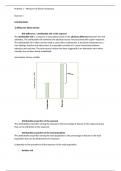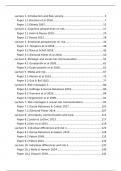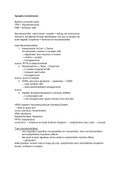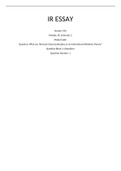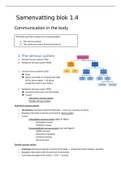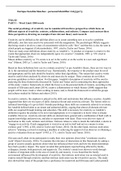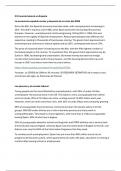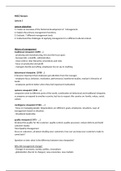Problem 1 – Mesaures of disease frequency
Exercise 1
Learning goals:
1) What are those terms:
- Risk difference / attributable risk of the exposed
The attributable risk is a measure of association based on the absolute difference between two risk
estimates. The attributable risk estimates the absolute excess risk associated with a given exposure.
The attributable risk if often used to imply a cause-effect relationship, it should be interpreted as a
true etiologic fraction only when there is reasonable certainty of a causal connection between
exposure and outcome. The term excess fraction has been suggested as an alternative term when
causality has not been firmly established.
Assumption: binary variable
- Attributable proportion of the exposed
The attributable proportion among the exposed is the percentage of disease in the exposure group
that can be attributed to the exposure.
- Attributable proportion of the total population
The attributable proportion among the total population is the percentage of disease in the total
population that can be attributed to the exposure.
It depends on the prevalence of the exposure in the total population.
- Relative risk
,Problem 1 – Mesaures of disease frequency
The relative risk is the ratio of the probability of an outcome in the exposed group to the probability
of an outcome in the unexposed group.
- Odds ratio
The odds ratio (OR) is a statistic that quantifies the strength of the association between two events.
The odds ratio is defined as the ratio of de odds of A in the presence of B and the odds of a in the
absence of B.
2) How to calculate those measures of association?
- Risk difference / attributable risk of the exposed
The attributable risk in the exposed is the difference between the risk estimates of difference
exposure levels and a reference exposure level (unexposed or lowest exposure level).
In other words; incidence+ - incidence-
A percent attributable risk in the exposed (%ARexp) is the ARexp expressed as a percentage of the
incidence+.
- Attributable proportion of the exposed
- Attributable proportion of the total population
, Problem 1 – Mesaures of disease frequency
- Relative risk
The relative risk of developing the disease is expressed as the ratio of the risk (incidence) in exposed
individuals to that in unexposed individuals.
In other words; the relative risk is the incidence of the exposed divided by the incidence of the
unexposed
RR = incidence+ / incidence –
RR = (a / a + b) / (c / c + d)
- Odds ratio
Odds = probability that an events will happen calculated over the probability that an events will not
happen.
The odds ratio (or relative odds) of disease development is the ratio of the odds of developing the
disease in exposed divided by that in unexposed. The odds od disease are based on incidence
proportions or probabilities.
Odds exposure / odds unexposed
Cohort study = odds exposed / odds unexposed
Case-control study = odds cases / odds controls
3) How to interpret those measures of association?
- Risk difference / attributable risk of the exposed
The attributable risk of the exposed is the absolute excess risk of developing the outcome (disease) in
the exposed compared to the unexposed. It is the difference between the incidence in the exposed
and the incidence in the unexposed.
- Attributable proportion of the exposed
Exercise 1
Learning goals:
1) What are those terms:
- Risk difference / attributable risk of the exposed
The attributable risk is a measure of association based on the absolute difference between two risk
estimates. The attributable risk estimates the absolute excess risk associated with a given exposure.
The attributable risk if often used to imply a cause-effect relationship, it should be interpreted as a
true etiologic fraction only when there is reasonable certainty of a causal connection between
exposure and outcome. The term excess fraction has been suggested as an alternative term when
causality has not been firmly established.
Assumption: binary variable
- Attributable proportion of the exposed
The attributable proportion among the exposed is the percentage of disease in the exposure group
that can be attributed to the exposure.
- Attributable proportion of the total population
The attributable proportion among the total population is the percentage of disease in the total
population that can be attributed to the exposure.
It depends on the prevalence of the exposure in the total population.
- Relative risk
,Problem 1 – Mesaures of disease frequency
The relative risk is the ratio of the probability of an outcome in the exposed group to the probability
of an outcome in the unexposed group.
- Odds ratio
The odds ratio (OR) is a statistic that quantifies the strength of the association between two events.
The odds ratio is defined as the ratio of de odds of A in the presence of B and the odds of a in the
absence of B.
2) How to calculate those measures of association?
- Risk difference / attributable risk of the exposed
The attributable risk in the exposed is the difference between the risk estimates of difference
exposure levels and a reference exposure level (unexposed or lowest exposure level).
In other words; incidence+ - incidence-
A percent attributable risk in the exposed (%ARexp) is the ARexp expressed as a percentage of the
incidence+.
- Attributable proportion of the exposed
- Attributable proportion of the total population
, Problem 1 – Mesaures of disease frequency
- Relative risk
The relative risk of developing the disease is expressed as the ratio of the risk (incidence) in exposed
individuals to that in unexposed individuals.
In other words; the relative risk is the incidence of the exposed divided by the incidence of the
unexposed
RR = incidence+ / incidence –
RR = (a / a + b) / (c / c + d)
- Odds ratio
Odds = probability that an events will happen calculated over the probability that an events will not
happen.
The odds ratio (or relative odds) of disease development is the ratio of the odds of developing the
disease in exposed divided by that in unexposed. The odds od disease are based on incidence
proportions or probabilities.
Odds exposure / odds unexposed
Cohort study = odds exposed / odds unexposed
Case-control study = odds cases / odds controls
3) How to interpret those measures of association?
- Risk difference / attributable risk of the exposed
The attributable risk of the exposed is the absolute excess risk of developing the outcome (disease) in
the exposed compared to the unexposed. It is the difference between the incidence in the exposed
and the incidence in the unexposed.
- Attributable proportion of the exposed


